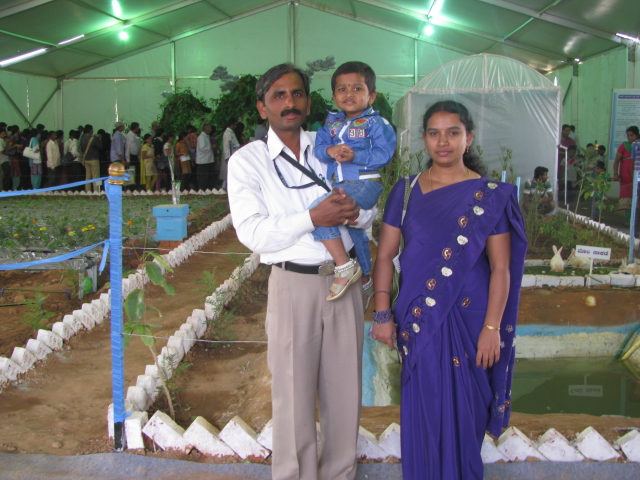
Date: Tue Aug 2, 2016
Time: 1:00 PM - 3:00 PM
Moderator: Victor Alchanatis
Agriculture is the largest consumer of water globally. As pressure on available water resources increases, the need to exploit technology in order to produce more food with less water becomes crucial. The technological hardware requisite for precise water delivery methods such as variable rate irrigation is commercially available. Despite that, techniques to formulate a timely, accurate prescription for those systems are inadequate. Spectral vegetation indices, especially Normalized Difference Vegetation Index (NDVI), are often used to gauge crop vigor and related parameters (e.g. leaf nitrogen content and grain yield). However, research heretofore rarely addresses the influence of soil moisture on the index. The objective of this study was to determine if NDVI derived from satellite imagery could assist in quantifying soil moisture variability in an irrigated maize production system. A variable rate irrigation pivot was used to form six water treatment zones. Each zone was equipped with a set of tensiometers installed in the center of the plots at 20, 45, and 75cm depths to individually monitor conditions in the water treatment zones. Water was applied for each treatment as a percentage of the estimated evapotranspiration (ET) requirement: i.e., 40, 60, 80, 100, 120, and 140 percent of the ET. Data collected from tensiometers was paired with the image pixels corresponding to the ground location of the tensiometers. Statistical analysis was performed separately to assess whether NDVI is representative of soil moisture at several crop growth stages. Findings from this study indicate that NDVI could quantify variability of soil moisture tension at maize crop growth stage R3 (milk) at 20cm (r2 = 0.70, p = 0.04) and 45 cm (r2 = 0.77, p = 0.02) depths. Results suggest that NDVI may be useful for evaluating seasonal soil moisture variability due to irrigation non-uniformity at large field-scales but is otherwise impractical for variable rate irrigation management. Further study is necessary to investigate additional crop growth stages, more crops, and other vegetation indices. Future studies are also needed to evaluate other sources of multispectral imagery.


Irrigation decisions based on traditional soil moisture sensing often leads to uncertainty regarding the true amount of water available to the plant. Plant based sensing of water stress decreases this uncertainty. In specialty crops grown in California’s Central Valley, precision deficit irrigation based on plant water stress could be used to decrease water use and increase water use efficiency by supplying the necessary quantity of water only when it is needed by the plant. However, there is a lack of a clear decision support system to implement stress-based precision irrigation on a management unit basis. Management zones were developed using an unsupervised fuzzy classification technique, where zone divisions were based on the soil characteristics of digital elevation, shallow electrical conductivity, sand, silt content and plant characteristics (leaf temperature and canopy cover). Management zones were most influenced by digital elevation. In both almonds and grapes, two zones were identified and two treatments were implemented. A leaf monitor was used to proximally sense the leaf temperature and microclimatic variables (relative humidity, air temperature, wind speed, and incident radiation) and compute a crop water stress index in almond and grape crops. Temperature differences between leaf surface and air were used to obtain stress indices. A wireless mesh network system was used to interface 14 leaf monitors in the almond plot while 10 leaf monitors interfaced to hubs equipped with cellular modems were used in the grape plot. In both cases data were transmitted to the web where they could be accessed in real-time to guide irrigation decisions. Plant water stress was estimated with respect to a well-watered and a simulated dry control tree. Variable rate irrigation was applied in almonds according to crop water stress levels in each management zone. Plant stress was evaluated in grapes in eight groups of five vines over a period of 10 days, where four groups were recovering through irrigation after experiencing severe stress and the other four groups were stressed by not applying water to the vines. In grapes, MCWSI and DSWP were found to be linearly related with a coefficient of determination value of 0.82. In almonds, a strong correlation resulted from comparison of CWSI and DSWP, obtained for each treatment of each zone; this yielded a second order polynomial relationship with a coefficient of multiple determination value of 0.79. In almonds, preliminary results indicated that Zone 1 required only 70% water compared to the grower treatment while Zone 2 required about 90% water compared to the grower treatment. These results suggest this method has the potential for increased water savings and increased water use efficiency.
Currently variable rate irrigation (VRI) prescription maps used to apply water differentially to irrigation management zones (IMZs) are static. They are developed once and used thereafter and thus do not respond to environmental variables which affect soil moisture conditions. Our approach for creating dynamic prescription maps is to use soil moisture sensors to estimate the amount of irrigation water needed to return each IMZ to an ideal soil moisture condition. The UGA Smart Sensor Array (UGA SSA) is an inexpensive wireless soil moisture sensing system which allows for a high density of sensor probes. Each probe includes three Watermark sensors. We use a modified van Genuchten model and soil matric potential data from each probe to estimate the volume of irrigation water needed to bring the soil profile of each IMZ back to 75% of field capacity. These estimates are converted into daily prescription maps which we downloaded remotely to a VRI controller thus creating a dynamic VRI control system. During 2015, we conducted an on-farm experiment to assess our system. We worked with a producer in a 230ac field in southwestern Georgia. The field was divided into alternating conventional irrigation and dynamic VRI strips with each strip 120 rows wide. The conventional strips were irrigated uniformly based on the producer’s recommendations. We divided the VRI strips into IMZs and after planting we installed UGA SSA probes in each of the IMZs. The data from the probes were used to develop daily irrigation scheduling recommendations for each IMZ. The recommendations were converted into a daily prescription map and downloaded remotely to the pivot VRI controller. When an irrigation event was initiated, the VRI-enabled pivot responded dynamically to soil moisture conditions. We will present the design of our dynamic VRI control system and the results from the 2015 study.

Accurate soil moisture content measurements are vital to precision irrigation management. Electromagnetic sensors such as capacitance and time domain reflectometry have been widely used for measuring soil moisture content for decades. However, to estimate average soil moisture content over a large area, a number of ground-based in-situ sensors would need to be installed, which would be expensive and labor intensive. Remote sensing using the microwave spectrum (such as GPS signals) has been used for measuring large area soil moisture contents. In our previous work we estimated surface soil moisture contents for bare soil using a GPS Delay Mapping Receiver (DMR) developed by NASA. However, the effect of vegetation was not considered in these studies. Hence the objectives of this study were to: 1) investigate the feasibility of using DMR to determine soil moisture content in cotton production fields; 2) evaluate the attenuation effect of vegetation (cotton) on GPS reflected signal. Field experiments were conducted during the 2013 and 2014 growing seasons in South Carolina. GPS antennas were mounted at three heights (1.6, 2.7, and 4.2 m) over cotton fields to measure GPS reflected signals (DMR readings). DMR readings, soil core samples, and plant measurements were collected about once a week and attenuation effect of plant canopy was calculated. Results showed that DMR was able to detect soil moisture changes within one week after precipitation events that were larger than 25 mm per day. However, the DMR readings were poorly correlated with soil volumetric water content during dry periods. Attenuation effect of plant canopy was not significant. For irrigation purpose, the results suggested that the sensitivity of GPS reflected signals to soil moisture changes needs to be further studied before this technology can be utilized for irrigation scheduling in cotton production.
A field experiment was conducted during kharif 2015 to asses the spatial variability and precision nutrient management through drip irrigation in aerobic rice at ZARS, GKVK, Bangalore. The experimental field has been delineated into 48 grids of 4.5 m x 4.5 m using geospatial technology. Soil samples from 0-15 cm depth were collected and analysed. There was spatial variability for available nitrogen (154 to 277 kg ha-1), phosphorous (45 to 152 kg ha-1) and potassium (200 to 346 kg ha-1). The variability was addressed through precision nutrient management approach with target yield. Application of 25 % N & K from sowing to 30 DAS + 25 % from 31 to 50 DAS + 25 % from 51 to 80 DAS + 25 % from 81 to 105 DAS through drip irrigation recorded significantly higher grain yield (11.0 Mg ha-1) over application of N & K as per package of practice (9.2 Mg ha-1) which was 20.2 per cent higher over application of N & K as per UAS (B) recommendations through drip irrigation and 70.1 per cent over soil application. Targeted yield of 12 Mg ha-1 recorded significantly higher grain yield (12.8 Mg ha-1) over rest of the targets. The actual yields were 22.0, 11.3, 8.2 and 7.3 per cent higher than the targeted yields of 6, 8, 10 and 12 Mg ha-1, respectively.

